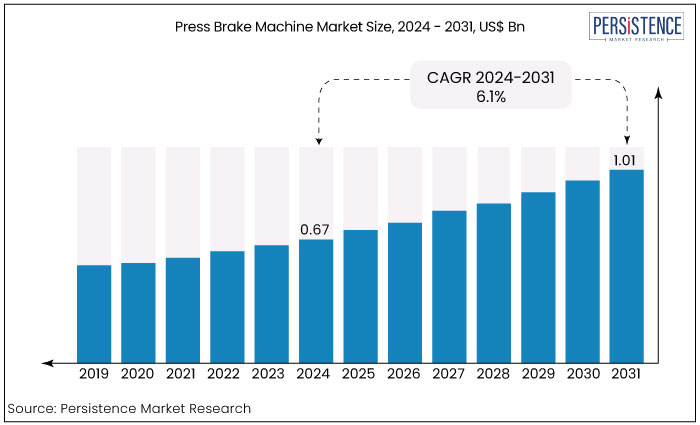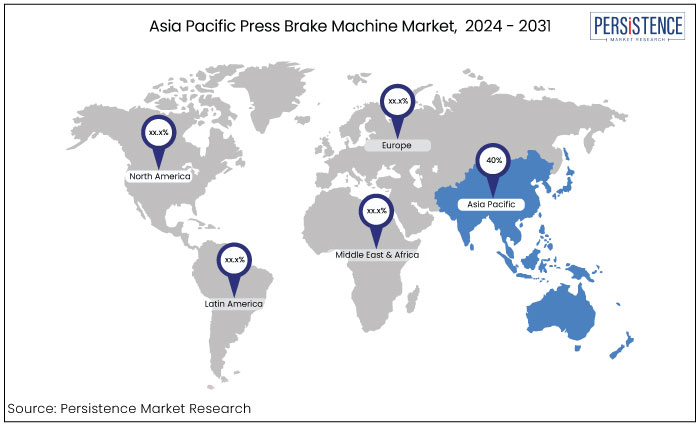Industry: Industrial Automation
Published Date: October-2024
Format: PPT*, PDF, EXCEL
Delivery Timelines: Contact Sales
Number of Pages: 177
Report ID: PMRREP30437
The press brake machine market is estimated to increase from US$0.67 Bn in 2024 to US$1.01 Bn by 2031. The market is projected to record a CAGR of 6.1% during the forecast period from 2024 to 2031. Expansion in emerging markets and a focus on energy efficiency offer opportunities, while competition remains strong among key global players.

Key Highlights of the Market
|
Market Attributes |
Key Insights |
|
Press Brake Machine Market Size (2024E) |
US$0.67 Bn |
|
Projected Market Value (2031F) |
US$1.01 Bn |
|
Global Market Growth Rate (CAGR 2024 to 2031) |
6.1% |
|
Historical Market Growth Rate (CAGR 2019 to 2023) |
5.5% |
|
Region |
Market Share in 2024 |
|
Asia Pacific |
40% |
The market for press brake machines is anticipated to benefit from urbanization and rapidly expanding economies, driven by substantial investments in manufacturing across the transportation, electronics, construction, and metal fabrication sectors. Asia pacific market to get 40% of the total market share.
Manufacturing activity is anticipated to expand considerably in Asia Pacific due to a combination of favourable government policies and infrastructure expenditures. The commercial transportation sector, encompassing aerospace, railways, and shipbuilding, is propelling the demand in Asia, hence enhancing potential prospects for press brake machine suppliers in the region.
South Asia Pacific market is anticipated to grow at a CAGR of 6.1%. In contrast, the East Asia market is expected to increase at a CAGR of 6.0% during the forecast period. The increasing air, rail, and maritime traffic volume in the Asia Pacific area is driving substantial investments in transportation infrastructure, including vehicle, airplane, and railway manufacturing.

|
Category |
Market Share in 2024 |
|
Product Type - Hydraulic Press Brake Machines |
52% |
Based on product type, the market is divided into mechanical press brake machines, pneumatic press brake machines, and hydraulic press brake machines. Among these, the hydraulic press brake machines dominate the market.
The most popular application for hydraulic press brake machines is in the processing of sheet metal, and it is estimated that these machines account for around 52% of the total volume share of the global market.
The hydraulic press brake machines use hydraulic fluids, which are quite popular because they are easy to operate, have a high-efficiency level, and are inexpensive. However, the demand for servo-electric press brake machines is anticipated to increase at a substantial compound annual growth rate, resulting in a market.
The fact that servo electric press brake machines come with digital controls, enhanced production capacity, and decreased energy usage is an additional benefit that these machines offer.
|
Category |
Market Value Share 2024 |
|
Capacity - 150-300 Tons |
32% |
Based on capacity, the market is divided into up to 50 tons, 50-150 tons, 150-300 tons, 300-500 tons, and above 500 tons. Among these, the 150-300 tons capacity segment dominates the market.
It is anticipated that the market worth of press brake machines with capacities ranging from 150 to 300 tons is estimated to own a substantial market share by the year 2031 with a growth rate of 6.4%.
The capacity of a press brake machine is determined by several specific parameters including the material of the sheet metal, its thickness, the number of components that need to be processed in a single day, and the maximum length of the material.
It is projected that press brake machines with capacities ranging from 150 to 300 tons will expand their market share because they have a larger range of applications in the transportation and electronics industries.
A press brake is a crucial apparatus in metal manufacturing, engineered for the precise bending and shaping of sheet steel. The clicking brake applies pressure to a work piece, employing a punch and die set to distort the material into a desired shape.
It provides adaptability in creating diverse angles, curves, and shapes rendering it an essential tool in the manufacturing, construction, and automotive sectors. The operator regulates the bending process by modifying parameters, cargo, and back gauge position facilitating complex components' precise and efficient fabrication in many metalworking applications.
The market for press brake machines is set for expansion especially in fast-urbanizing areas and economies experiencing increased manufacturing activities. The automotive and electronics sectors are anticipated to spearhead demand due to their need for precise sheet metal components. With the escalation of manufacturing and construction activities, the need for press brake machines is expected to increase, driving market growth.
The press brake machine market experienced steady growth leading up to 2023 driven primarily by the increasing demand for metal fabrication in key industries such as automotive, aerospace, construction, and heavy machinery.
Technological advancements such as the integration of automation and computer numerical control (CNC) systems, enhanced machine efficiency and precision significantly boosting production capabilities. Further, the growing need for lightweight and custom metal components further stimulated market growth as manufacturers sought advanced bending solutions.
Post-2024, the press brake machine market is expected to witness accelerated expansion, fueled by the increasing adoption of Industry 4.0 technologies and smart manufacturing. Automated press brake machines, equipped with robotics and AI-driven systems are projected to dominate, enabling higher productivity, reduced errors, and lower operational costs.
Sustainability trends emphasizing energy-efficient machinery and reduced waste in metal fabrication will further influence market dynamics. The rise in demand for electric press brakes, which offer better energy efficiency compared to traditional hydraulic models, is also anticipated to drive growth.
Expanding infrastructure development in emerging economies and the push for electric vehicles will create further demand for press brake machines. Overall, the market is expected to maintain a healthy compound annual growth rate (CAGR) as industries continue to prioritize advanced manufacturing technologies.
Growing Demand for Metal Fabrication in Key Industries
The press brake machine market is significantly driven by the increasing demand for metal fabrication across automotive, aerospace, construction, and manufacturing industries. Press brake machines are essential in precisely bending and shaping metal components, making them crucial for producing vehicle frames, structural elements, and custom metal parts.
The automotive industry has seen heightened demand due to the rise in electric vehicle (EV) production, which requires lightweight but durable metal components. The construction industry’s ongoing infrastructure development, particularly in emerging economies, fuels the demand for fabricated metal, further driving the need for advanced press brake machines.
As industries continue to innovate and expand, press brake machines are becoming vital in meeting the demand for high-quality, precision-engineered metal products.
Technological Advancements and Automation
Technological advancements, particularly the integration of automation and computer numerical control (CNC) systems, are transforming the press brake machine market. CNC press brakes allow manufacturers to achieve high levels of precision and efficiency, making the bending and shaping of metal components faster and more accurate.
The automation of press brake machines reduces the need for manual labor, minimizes errors, and significantly increases productivity. Automated systems can be easily programmed for complex, repeatable tasks, enabling mass production while maintaining consistency in quality.
The growing adoption of Industry 4.0 technologies, such as AI and robotics, also enhances machine capabilities, allowing for predictive maintenance and real-time monitoring. These innovations improve operational efficiency and help manufacturers meet the rising demand for customized metal products.
High Initial Costs of Advanced Press Brake Machines
One of the primary restraints in the press brake machine market is the high initial cost associated with acquiring advanced models particularly those equipped with CNC technology and automation features.
Such machines, while offering significant long-term benefits such as increased efficiency and precision, require a substantial upfront investment. Small and medium-sized enterprises (SMEs) often face budget constraints that make it challenging to invest in such equipment, limiting their ability to modernize and scale their operations.
The cost of skilled labour needed to operate and maintain these advanced machines can further increase operational expenses. As a result, many manufacturers may opt for cheaper, less advanced alternatives, slowing the widespread adoption of cutting-edge press brake technology especially in price-sensitive markets.
Shortage of Skilled Labour
Another significant restraint affecting the press brake machine market is the shortage of skilled labor capable of operating advanced CNC and automated machines. The growing complexity of modern press brakes requires operators with specialized training in programming and machine maintenance.
The industry faces a talent gap as fewer workers possess the technical expertise required to run these machines effectively. This shortage is particularly pronounced in regions with limited vocational training in metal fabrication and CNC operations.
The lack of skilled operators not only hampers productivity but also increases the risk of operational errors, making it difficult for manufacturers to leverage modern press brake machines' capabilities fully. Addressing this challenge requires investment in workforce development and training programs to bridge the skills gap.
Expansion of Smart Manufacturing and Industry 4.0 Integration
One of the most transformative opportunities in the press brake machine market is the expansion of smart manufacturing and the integration of Industry 4.0 technologies. Industry 4.0, which encompasses automation, data exchange, IoT, AI, and robotics, allows press brake machines to become part of a highly connected and efficient production environment.
With smart press brake machines, manufacturers can monitor equipment performance in real time, predict maintenance needs, and optimize production processes for great accuracy and efficiency. This transition enables companies to reduce downtime and improve output quality significantly.
As the adoption of smart factories grows, manufacturers offering press brakes with advanced digital features will gain a competitive edge by catering to the demand for more integrated, connected, and data-driven production environments. This also opens up opportunities for smaller manufacturers to scale up their operations with more automated, intelligent systems.
The competitive landscape of the press brake machine market is characterized by the presence of established global players and emerging regional manufacturers. Leading companies like AMADA, TRUMPF, and Bystronic dominate the market with advanced product portfolios, including CNC and automated press brakes catering to large-scale industrial needs.
Key players invest heavily in R&D to introduce innovative and efficient machines, focusing on smart manufacturing and Industry 4.0 integration. In contrast, small and regional manufacturers offer more cost-effective solutions targeting small and medium-sized enterprises (SMEs).
The market is also competitive in terms of technological advancements, sustainability initiatives, and customization options. As competition intensifies, manufacturers aim to differentiate themselves through enhanced automation, precision, and energy-efficient machines.
Recent Industry Developments in the Press Brake Machine Market
|
Attributes |
Details |
|
Forecast Period |
2024 to 2031 |
|
Historical Data Available for |
2019 to 2023 |
|
Market Analysis |
US$ Billion for Value |
|
Key Regions Covered |
|
|
Key Market Segments Covered |
|
|
Key Companies Profiled in the Report |
|
|
Report Coverage |
|
|
Customization & Pricing |
Available upon request |
By Product Type
By Capacity
By Operation
By Region
To know more about delivery timeline for this report Contact Sales

The market is estimated to be valued at US$1.01 Bn by 2031.
The market is projected to exhibit a CAGR of 6.1% over the forecast period.
Some of the key industry players in the market are Trumpf, AMADA, AIZAWA TEKKOSHO LTD, and Boschert.
Asia Pacific region dominates the market.
Hydraulic press brake machines lead the market with significant market share.